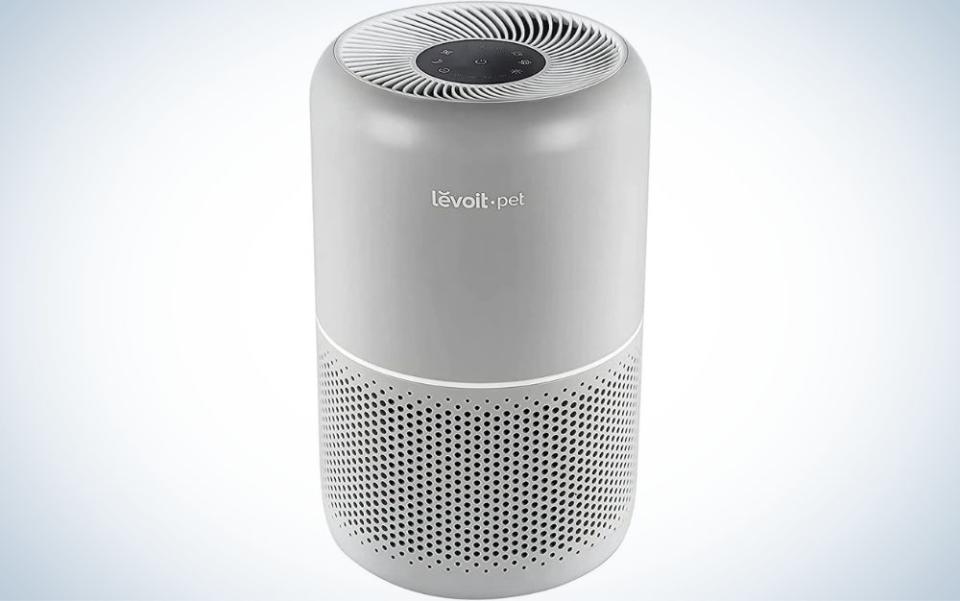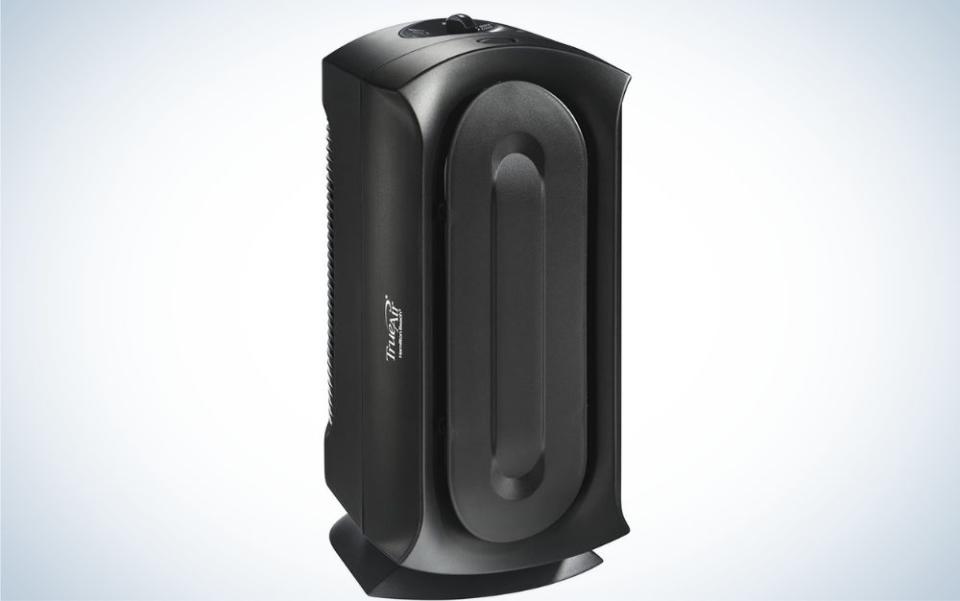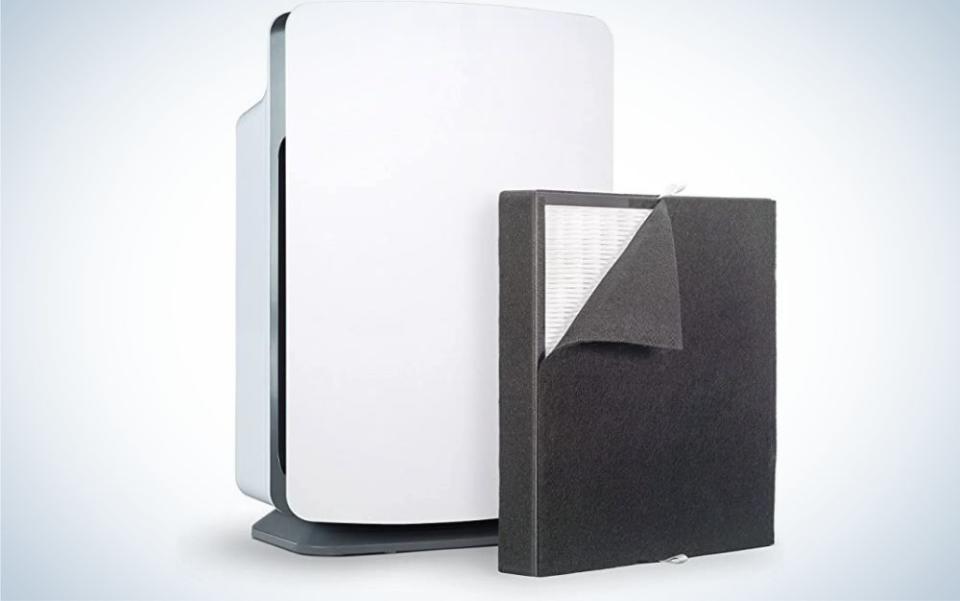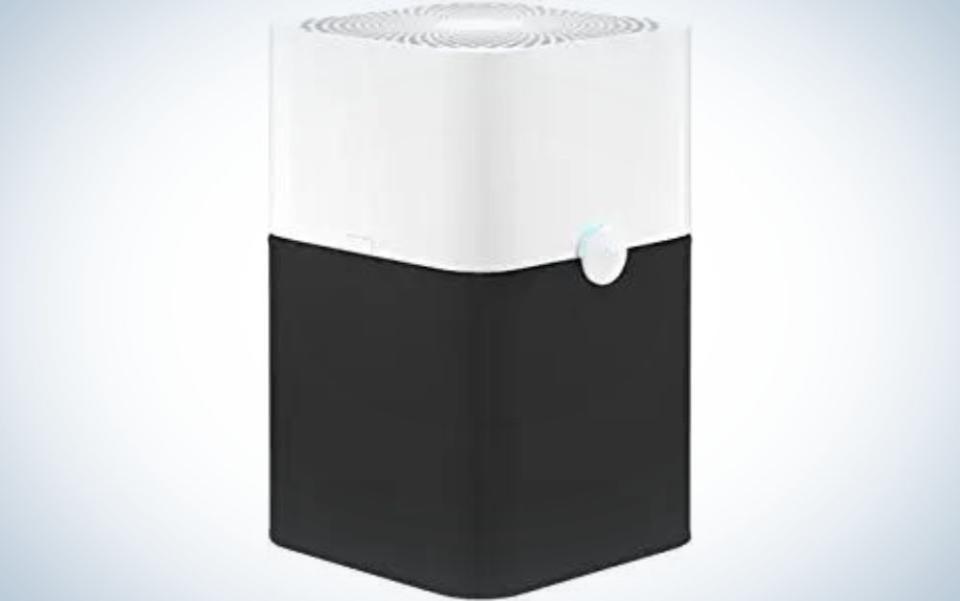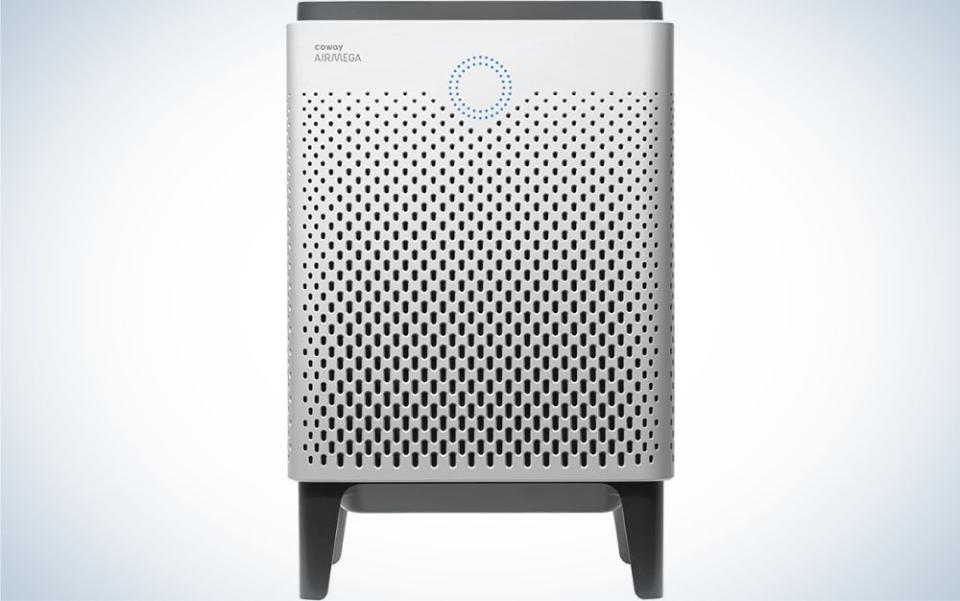The Best Air Purifiers for Pets in 2023
Allergies don’t have to prevent you from becoming a pet parent. The best air purifiers for pets cleanse the breathable air to create a cleaner, allergy-friendly home with your favorite furry friends. These purifiers target the specific challenges that come with pet ownership, which typically include odor, pet dander, and pet hair.
The size of the room, number of pets, and particulates you’d like to target will all influence the type, size, and filters you need. Extra features like pet or child locks and smart settings can make it easier to take a deep breath without inhaling unpleasant odors or pet hair. Our list of the best air purifiers for pets ranges from models that specifically target pet hair to those that excel in removing odors.
— Best Overall: Levoit Core P350
— Best Budget: Hamilton Beach TrueAir Air Purifier
— Best for Pet Odor: Alen BreatheSmart Classic Large Room Air Purifier
— Best for Pet Hair: Blueair Blue 211+ HEPASilent Air Purifier
— Best for Large Room: Coway Airmega 400 Smart Air Purifier
How We Picked the Best Air Purifiers for Pets
We researched air purifier filter types, Clean Air Delivery Rates (CADR), recommended room size, and extra features that work best for pet homes. We also considered the performance record for each model that made it on the list.
Filter Types: For pet homes, High-Efficiency Particulate Air (HEPA) filters are one of the most important factors. We researched models with true HEPA filters to target allergy-inducing pet dander. However, a couple of models with HEPA-like filters made the list because of the strength of their other features. If you’re not trying to control allergies, a HEPA filter isn’t absolutely necessary, though you’ll get the best filtration with one. Prefilters and carbon filters were the other types we considered. Prefilters target large particles and carbon filters absorb pet odors.
CADR: We noted CADR when available, including the separate scores for dust, smoke, and pollen. Unfortunately, some manufacturers don’t report the CADR at all or may only report one CADR number without specifying whether it’s for dust, smoke, or pollen.
Room Size: We included the best air purifiers for pets that work in rooms of various sizes to accommodate different home layouts.
Extra Features: Air purifiers can come with a long list of extra features that you may or may not need. A basic purifier with two or three fan settings is all most people need. However, models with built-in sensors and auto settings are useful if you prefer to set up the air purifier and let it go without fiddling with the controls.
The Best Air Purifiers for Pets: Reviews and Recommendations
Best Overall: Levoit Core P350
Why It Made The Cut: Specifically designed for pet homes, this Levoit efficiently removes allergens, odors, and pet hair in areas up to 219 square feet.
Specs:
— Dimensions: 8.7 inches L x 8.7 inches W x 14.2 inches H
— Recommended Room Size: 219 square feet
— CADR: 240 (unspecified)
Pros:
— Prefilter removes large particles
— Night setting runs at only 24 dB (decibels)
— Multiple fan settings
— Petlock prevents tampering
Cons:
— Some users report a chemical smell after a few months of use
The Levoit Core P350 specifically targets pet problem areas like dander, hair, and odors, making it an excellent pet air cleaner. The three-layer filtration system starts with a non-woven, fabric pre-filter that captures large particles. It’s reusable and requires cleaning every few months. (The more pets you have, the more frequently you’ll need to clean this filter.)
The second stage of filtration is a true HEPA filter that removes allergens, like pet dander. (This filter generally needs replacement every six to eight months.) The P350 targets odors with an activated carbon filter with ARC technology that absorbs and chemically decomposes odors.
This model also comes with some user- and pet-friendly extras, including a petlock that prevents pets (or children) from tampering with the settings, a check filter indicator, and an option to turn off the display lights. It also has two-, four-, six-, and eight-hour timers. (For the best filtration, we always recommend running an air purifier 24/7, but you can use the timers to enhance energy efficiency.) Finally, this model has three speed settings and a night setting that runs at a quiet 24 decibels. However, a few users report a chemical smell after a few months of use. Filter replacement seems to fix the issue, though it’s not a problem found in every unit.
Best Budget: Hamilton Beach TrueAir Air Purifier
Why It Made The Cut: The Hamilton Beach’s reusable HEPA-grade filter and dual orientation options make it versatile and affordable.
Specs:
— Dimensions: 8.5 inches L x 6 inches W x 13.54 inches H
— Recommended Room Size: 160 square feet
— CADR: NA
Pros:
— Permanent HEPA-grade filter
— Horizontal or vertical orientation
— Three speeds
Cons:
— Doesn’t remove odors
— Doesn’t have a true HEPA filter
The Hamilton Beach TrueAir Air Purifier is a steal of a deal if you’ve got a relatively small space you’d like to keep cleaner. This unit removes particles down to three microns in a 160 square foot space. That’s small enough to remove pet hair, some dander, and many allergens, though not all. (A true HEPA filter removes particles down to 0.3 microns.) You are giving up some allergen filtration with this model, but it still does a good job of removing hair and other large particles.
One of the great things about this air purifier is that it saves you money in the short and long run. It’s affordable upfront, and it has a permanent, reusable filter that needs vacuuming every three to six months.
Another perk is the horizontal or vertical orientation to better fit in a variety of spaces. The three speeds let you adjust not only the filtration speed, but the noise level based on your needs.
This air purifier skips bells and whistles to keep things basic and affordable. It’s a good choice for spaces where pets visit but don’t necessarily frequent for the better part of the day.
Best for Pet Odor: Alen BreatheSmart Classic Large Room Air Purifier
Why It Made The Cut: The BreatheSmart comes in a pet-specific option that neutralizes pet odors and removes allergens with a true HEPA filter that replaces the air in a 1,100 square-foot space every 30 minutes.
Specs:
— Dimensions: 10 inches L x 17.75 inches W x 21 inches H
— Recommended Room Size: 1,100 square feet
— CADR: 300 (unspecified)
Pros:
— Customizable filter
— Customize the finish
— Huge coverage area
— Sensor automatically detects air quality
Cons:
— Large
— Expensive
The Alen BreatheSmart Classic Large Room Air Purifier is a premium air purifier for dog smell (and cat) with several customization options and a huge coverage area. Upon purchase, you can choose one of four filter types. Of those four, the OdorCell filter neutralizes pet odors while also trapping allergens and pet dander. However, the FreshPlus filter, which uses a chemical air filter to remove allergens, odors, VOCs, and smoke, is another option for pet owners. Either one will keep pet dander and odors from taking over your home. You can further customize this air purifier by choosing one of six finishes.
The sheer power and size of this air purifier prevent odors from permeating the home. On the highest setting, it can completely replace the air in a 1,100 square-foot room in 30 minutes.
The BreatheSmart comes with a hefty price, but that price includes extra features like a timer, filter meter that lets you know when the filter starts to get full, four speeds, and an auto setting. The auto setting uses a built-in sensor that detects air purification levels. When the levels fall below the acceptable range, the air purifier automatically turns on, preventing the BreatheSmart from running when the air is clean. Keep in mind that this powerful air purifier has a big price tag and footprint. It can easily visually overpower a small room.
Best for Pet Hair: Blueair Blue 211+ HEPASilent Air Purifier
Why It Made The Cut: The 211+ tackles pet hair with a reusable fabric pre-filter in an energy efficient design.
Specs:
— Dimensions: 13 inches L x 13 inches W x 20.4 inches H
— Recommended Room Size: 540 square feet
— CADR: 350 (smoke, pollen, and dust)
Pros:
— Reusable fabric pre-filter
— Electrostatic filtration removes 99.97 percent of particles
— Activated carbon filter removes some odors
Cons:
— May have an odor for a few days after opening
— Doesn’t have a true HEPA filter
The Blueair Blue 211+ HEPASilent Air Purifier is one of the best air purifiers for pets, thanks to a reusable fabric pre-filter that’s an ideal air filter for pet hair and powerful suction. We want to point out that the name HEPASilent can be a bit deceiving with this model. It doesn’t have a true HEPA filter, but an electrostatic filter that removes particles down to .1 microns. It’s not quite the same standard as a HEPA filter, but the CADR rating of 300 for pollen, dust, and smoke show that it’s still highly effective.
In the recommended 540 square foot space, this model can replace all of the air in the room 4.8 times in an hour. That power removes a significant amount of floating hair through the pre-filter. When the pre-filter gets full, which it inevitably will, you can toss it in the washing machine, let it fully dry, and put it back on. Blueair offers extra fabric coverings in different colors if you want to mix and match with your decor.
The 211+ also has an activated carbon filter that can reduce minor odors. However, if you have a particularly stinky pet or multiple pets, you may need a model with multiple activated carbon filters to rid the home of odors. As a potential downside, the 211+ has been known to have a bit of an odor itself for the first few days.
Best for Large Rooms: Coway Airmega 400 Smart Air Purifier
Why It Made The Cut: The Coway’s pre-filter, HEPA filter, and carbon filter effectively clean the air twice every hour in rooms up to 1,560 square feet.
Specs:
— Dimensions: 14.8 inches L x 14.8 inches W x 22.8 inches H
— Recommended Room Size: up to 1,560 square feet
— CADR: 328 (smoke and dust), 400 (pollen)
Pros:
— Automatic air quality sensor
— Reusable pre-filter
— Filter indicator lights
— Smart mode
Cons:
— Large
— Expensive
The Coway Airmega 400 Smart Air Purifier takes on big rooms with an automatic air quality sensor and premium features like a smart mode and filter indicator lights. It’s right on par with the Airdog X5 Air Purifier (a powerful pet specific air purifier) in price, but the Coway covers a much larger area. This large air purifier is designed for rooms up to 1,560 square feet. In a room that large, it can completely replace the air two times per hour.
This model can be an energy saver, especially when in smart mode. On smart mode, the air-quality sensor adjusts the settings based on the detected air pollution, increasing or decreasing the airflow based on sensor readings. The smart settings also activate the light ring on the front of the unit, changing color as the air quality decreases. Additionally, an eco-mode turns off the fan if the air quality stays purified for a continuous ten minutes.
As one of the best air purifiers for pets, it has a three-stage filtration system that includes a pre-filter, true HEPA filter, and activated carbon filter. You can also set your own schedule using three timer settings. While this unit is large and expensive, it’s an efficient solution for large rooms or an open floor plan.
Things to Consider Before Buying an Air Purifier for Pets
Filter Types: Air purifiers can come with one or more types of filters. Each filter type has a slightly different purpose, targeting different particles. Ask yourself if pet hair, dander, or odors are more of a problem for you. Some people may have issues with all three, which means you’ll probably need a three-stage filtration system.
— HEPA Filters: HEPA filters remove up to 99.97 percent of airborne particles down to 0.3 microns. They’re a mechanical filter that traps particles in the filter fibers. These filters remove pet dander, mold, and dust, making them one of the most effective filter types. If you need an air purifier for cat allergies or pet dander, make sure that the air purifier has a HEPA filter or true HEPA filter, not just a HEPA-like or HEPA-grade filter. The later designation may function similarly to a HEPA filter but may not help with allergies like a true HEPA filter. Keep in mind that HEPA filters cannot completely remove odors, smoke, or fumes, though they can reduce odors because they can remove some particles that cause them.
— Electrostatic Filters: Electrostatic filters rely on static electricity to attract unwanted particles like pet hair and dust. They’re not as effective as HEPA filters, but they’re a more economical choice because they cost less to replace, and can be disposable and reusable. The reusable type can be washed clean and reused over and over again, saving the costs of replacing the filter.
— Carbon-Activated Filters: Carbon-activated filters absorb odors and gasses, including pet odors, cigarette smoke, and some volatile organic compounds (VOCs). These filters may be treated with chemicals to target specific pollutants. While these filters do an excellent job of removing odors and fumes, they get saturated over time and need to be replaced regularly. They’re also expensive to replace.
— UV Filters: Ultraviolet (UV) filters use UV light to kill bacteria and viruses. While these filters can help keep your home cleaner, most bacteria and viruses require longer exposure to UV light than an air purifier can provide.
— Negative Ion and Ozone Filters: Negative ion and ozone filters work by releasing ions that attach and weigh down unwanted particles, causing them to fall out of the breathable air space. However, both negative ion and ozone filters can release harmful ozone. Consequently, we don’t recommend them.
CADR: The Clean Air Delivery Rate, or CADR, is used by the Association of Home Appliance Manufacturers (AHAM) to measure an air purifier’s effectiveness. Air Purifiers can get three CADR ratings, one for dust, smoke, and pollen. The CADR indicates the air purifier’s efficiency at removing particles within each category based on room space and the volume of clean air the air purifier produces per minute. That number is then converted into cubic meters per hour. The rating takes into account the particle size, percentage of the particles that are removed, and volume of air the air purifier produces. All you need to know is that the higher the CADR, the more efficient and better at cleaning air the air purifier is. Not every manufacturer includes a CADR with their products, but those that do make it easier to compare models based on a recognized third-party standard.
Room Size: The size of the room in which you will use the air purifier makes a huge difference in the model you choose. The air purifier should be able to clean the air in a space slightly larger than the room size. A model that’s too small won’t be able to effectively clean the air. One that’s too large will use more energy than is needed to keep the room’s air clean.
Extra Features: The best air purifiers for pets can come with many helpful, though not absolutely necessary extra features. Timers, auto settings, air quality sensors, and smart features are among the most common. Auto settings and sensors can reduce energy use while timers can set a schedule. However, to truly keep allergens at bay, an air purifier should run 24/7.
FAQs
Q. How often do air purifier filters need to be replaced?
How often you replace air purifier filters depends on a few factors, like the size of the air purifier, the amount of particles in the air, and the types of filters used. For example, if you have several pets or live in an area with frequent wildfires, your HEPA filter and activated-carbon filter may need frequent replacement. In general, pre-filters that remove the largest particles need replacing or cleaning every three or four months. HEPA filters need replacing every year or two (more often in multi-pet homes). Activated carbon filters last anywhere from a few months to a year.
Q. What's the difference between true HEPA and HEPA-type filters?
The difference between a true HEPA filter and a HEPA-type or HEPA-like filter comes down to their ability to trap airborne particles. A true HEPA filter can trap 99.97 percent of particles down to 0.3 microns. HEPA-type and HEPA-like filters aren’t as efficient and cannot claim to be a true HEPA filter, though they may still remove particles down to one to three microns.
Q. How much does an air purifier for pets cost?
The best air purifiers for pets can cost anywhere from $35 to over $600, depending on the size and types of filters they include. Larger models with pre-filters, a HEPA filter, and activated carbon filter that also have a built-in timer and smart features or remote control will be at the top of the price range. A small model designed for a 150 to 300 square foot space that only has a pre-filter and HEPA filter may fall at the bottom of the price range.
Q. Where do I recycle my air purifier?
Not every recycling facility can recycle air purifiers. Your local sanitation department may be able to offer some guidance. Other options include contacting Responsible Appliance Disposal (RAD) to learn of local options, specialty recycling programs or facilities in your area, and local scrap yards.
Q. Should I buy an air purifier for allergies?
Air purifiers can help with some allergies. A model with a true HEPA filter is your best option because they remove pet dander, pet hair, and other allergens. However, for the air purifier to make a difference in allergies, it will need to run 24/7. If it’s only running when you’re in the room, the allergens will return to the breathable air when the air purifier turns off.
Final Thoughts on the Best Air Purifiers for Pets
— Best Overall: Levoit Core P350
— Best Budget: Hamilton Beach TrueAir Air Purifier
— Best for Pet Odor: Alen BreatheSmart Classic Large Room Air Purifier
— Best for Pet Hair: Blueair Blue 211+ HEPASilent Air Purifier
— Best for Large Room: Coway Airmega 400 Smart Air Purifier
For the majority of homes, the Levoit Core P350 offers the best blend of air purification, sleek design, and extra features. The petlock is particularly helpful in homes with pets (or kids) to keep anyone from tampering with the fan speed or timer settings. If you’re strictly targeting pet hair and dander, the Hamilton Beach TrueAir Air Purifier is an affordable option with dual orientation. It also saves you money in the long run with the permanent, reusable filter.
Why Trust Us
Let’s get one thing out of the way: Online shopping is hard. Search for any product and you’ll be confronted with dozens (if not hundreds or thousands) of choices. Our mission at Futurism, where we cover the latest technology, is to simplify this experience by researching, testing, and continuing to evaluate products so we only recommend choices that are actually worth your time.
This post was created by a non-news editorial team at Recurrent Media, Futurism’s owner. Futurism may receive a portion of sales on products linked within this post.
